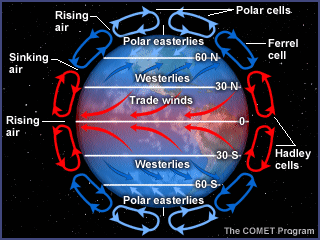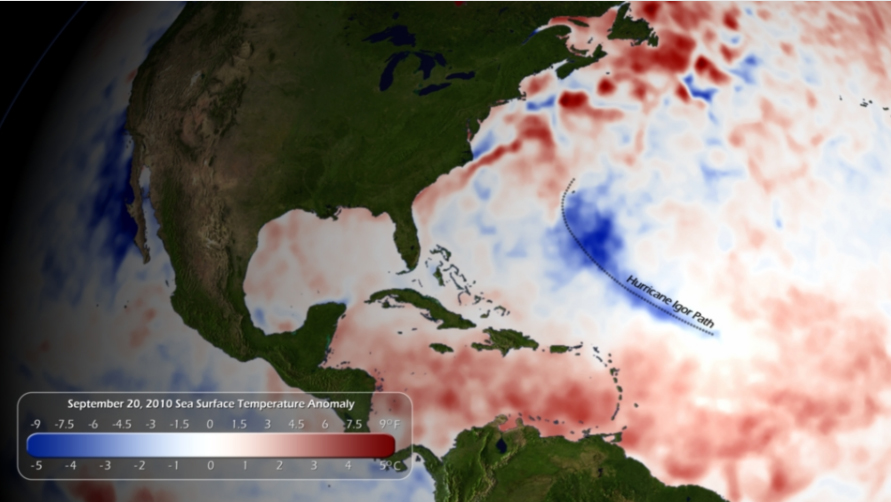A Hurricane's
Purpose

Hurricanes are one of the most dangerous weather phenomena in nature, and it is a worthwhile question to wonder exactly why they exist and what role they play in the Earth's weather system as a whole. The answer lies almost solely in the fact that the Earth's atmospheric circulation is driven by energy embalances between the equator and the poles due to the Earth's spherical shape, axis tilt, and orbit. Air is constantly rising in the equatorial regions Image Courtesy: UCAR: The COMET Program
on the equatorword side of the Hadley
circulation cell because it is relatively warmer than the air in the mid-latitude and polar regions. The Earth's circulation is constantly attempting to alleviate this gradient and reach thermal equilibrium. Tropical cyclones are one of the atmosphere's best tools for transporting heat poleward, as they take thermal energy from the oceans and the atmosphere, convert some of it into kinetic energy, and carry the rest of it with them as they recurve into the mid-latitudes, where it is deposited into the Ferrel and Polar circulation cells. Hurricanes are also a result, not only of the horizontal temperature gradient on the Earth, but of the vertical gradient as well. Because of the composition of our atmosphere, it is very hard for solar energy to get conducted upwards from the ground to the top of the troposphere, and thus convection mechanisms exist to help mix the atmosphere, getting heat from the bottom to the top.
 The cold sea surface temperature wake left
by Hurricane Igor in 2010 after taking energy out of the ocean. Image Courtesy: National
Oceanic
and Atmospheric Administration
The cold sea surface temperature wake left
by Hurricane Igor in 2010 after taking energy out of the ocean. Image Courtesy: National
Oceanic
and Atmospheric Administration
Overall, hurricanes are a necessary part of the Earth's atmospheric circulation, but there is still a lot to be studied about their effects on the polar regions and exactly how much they influence heat transport. An interesting area of research is in how much energy is transported poleward by hurricanes every year, and how that evolves over time. Approximations of the total energy released by tropical cyclones have already been developed, but they do little in the way of telling us where that energy went. Developing a way to determine this could add valuable knowledge to how the Earth's climate regulates.

Hurricanes are one of the most dangerous weather phenomena in nature, and it is a worthwhile question to wonder exactly why they exist and what role they play in the Earth's weather system as a whole. The answer lies almost solely in the fact that the Earth's atmospheric circulation is driven by energy embalances between the equator and the poles due to the Earth's spherical shape, axis tilt, and orbit. Air is constantly rising in the equatorial regions Image Courtesy: UCAR: The COMET Program
on the equatorword side of the Hadley
circulation cell because it is relatively warmer than the air in the mid-latitude and polar regions. The Earth's circulation is constantly attempting to alleviate this gradient and reach thermal equilibrium. Tropical cyclones are one of the atmosphere's best tools for transporting heat poleward, as they take thermal energy from the oceans and the atmosphere, convert some of it into kinetic energy, and carry the rest of it with them as they recurve into the mid-latitudes, where it is deposited into the Ferrel and Polar circulation cells. Hurricanes are also a result, not only of the horizontal temperature gradient on the Earth, but of the vertical gradient as well. Because of the composition of our atmosphere, it is very hard for solar energy to get conducted upwards from the ground to the top of the troposphere, and thus convection mechanisms exist to help mix the atmosphere, getting heat from the bottom to the top.
 The cold sea surface temperature wake left
by Hurricane Igor in 2010 after taking energy out of the ocean. Image Courtesy: National
Oceanic
and Atmospheric Administration
The cold sea surface temperature wake left
by Hurricane Igor in 2010 after taking energy out of the ocean. Image Courtesy: National
Oceanic
and Atmospheric AdministrationOverall, hurricanes are a necessary part of the Earth's atmospheric circulation, but there is still a lot to be studied about their effects on the polar regions and exactly how much they influence heat transport. An interesting area of research is in how much energy is transported poleward by hurricanes every year, and how that evolves over time. Approximations of the total energy released by tropical cyclones have already been developed, but they do little in the way of telling us where that energy went. Developing a way to determine this could add valuable knowledge to how the Earth's climate regulates.